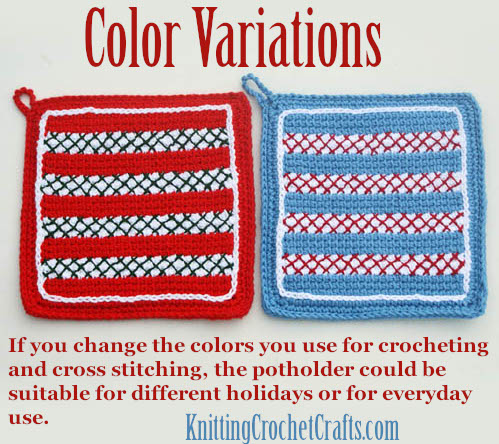Get the Free Pattern for Crocheting Striped Christmas Potholders With Cross Stitch HERE!

Want to make potholders like these? If so, you’ll use two interesting techniques to stitch them:
- Tunisian crochet, and
- Cross stitch on crochet.
These techniques complement each other beautifully.
How they work together: Instead of buying aida fabric, like cross stitchers often do, you crochet the fabric you’ll use to cross stitch on top of. The fabric you’ll crochet is basically a small, striped, potholder-sized square, worked in afghan stitch. Then you use your crochet stitches as the guidelines for placing the cross stitch.
To finish, you create a solid-colored back in afghan stitch, then join the two pieces together using a simple edging.
Want to give it a try? Here’s the free pattern:
Materials:
Yarn:
For each potholder, you’ll need a total of approximately 3 oz. of worsted weight cotton yarn. You’ll need yarn in 2 different colors: color A and color B, approximately 2.5 oz color A and about .5 oz color B. In the sample shown above, red is color A and white is color B.
The sample was worked in Peaches & Creme 4 ply cotton yarn in red and white. Feel free to substitute any similar cotton yarn if you prefer.
To crochet one potholder, I used up close to an entire 2.5 oz ball of yarn in color A and much less than one ball of color B. Due to variations in the way each person crochets, you might use a bit more or a bit less than I did. If you’re buying new yarn for this project, I’d recommend buying one extra 2.5 oz ball of color A to ensure that you don’t run out of yarn.
For example, if you want to make two potholders, I’d recommend buying 3 balls of color A. You might end up needing that third ball, or you might not, but it’s better to have it on hand than to run out.
Crochet Hooks:
For the Body of the Potholder: You’ll need a size J / 10 /6.0 mm Tunisian crochet hook (also known as an afghan crochet hook) measuring 10+ inches long, or your preferred size.
For the Edging: Try an ordinary size H crochet hook to start with; you may need to adjust up or down if you notice a significant difference in tension between the body of your potholder and your edging.
Embroidery Floss: 3 skeins of dark green. The sample was made using DMC color 890.
Avoid Color Bleeding: Make sure to use a colorfast embroidery floss. Vintage embroidery floss might not be colorfast. This is a concern because the colors could bleed when you wash the potholder. If in doubt, wet a small piece of the floss to see if it bleeds before using it.
Other: Tapestry needle and safety pins
Abbreviations:
- ch = chain
- ea = each
- sc = single crochet
- sl st = slip stitch
- st(s) = stitch(es)
Size of Each Finished Potholder:
One potholder measures approximately 8 ¾ inches square before washing. This measurement includes the edging. The potholders can be expected to shrink slightly when you launder them.
Gauge:
11 stitches = 3 inches. The row gauge isn’t critical for this project.
Pattern Notes:
Afghan stitch has a tendency to curl up, so do not be alarmed if your work curls. The potholder will lie flat once you join the pieces together.
How to Crochet the Potholders:
Front of Potholder:
Using color A, ch 27.
Begin using your Tunisian crochet hook. Work in afghan stitch (also known as Tunisian simple stitch) until directed otherwise.
Rows 1-3: Use color A.
Rows 4-6: Use color B.
Rows 7-9: Use color A.
Rows 10-12: Use color B.
Rows 13-15: Use color A.
Rows 16-18: Use color B.
Rows 19-21: Use color A.
Rows 22-24: Use color B.
Rows 25-27: Use color A.
Row 28: Work one sl st in ea vertical bar all the way across the row. Work one last sl st into the end of the row, in the same spot you’d ordinarily work the last afghan stitch in the row. (This gives you a total of 26 sl sts in the row.)
Edging Round 1: Switch to your ordinary crochet hook. Work in rounds. Ch 2, then work one sc st in ea stitch, all the way around. When you get to the corners: (sc, ch 2, sc in the same stitch) and then continue working sc. Join with a sl st.
Weave in all ends.
Cross Stitch Details:
Using green embroidery floss, cross stitch in a checkerboard pattern overtop of the stripes worked in color B.
Slip Stitch Detail:
Using color B, work a round of slip stitches on the surface of the potholder. This gives some visual separation between the afghan stitch and the edging.
Back of Potholder:
Using color A, ch 27.
Work 27 rows of afghan stitch in color A.
Row 28: Work one slip stitch in ea vertical bar all the way across the row. Work one last slip stitch into the end of the row, in the same spot you’d ordinarily work the last afghan stitch in the row. (26 slip stitches worked.)
Edging Round 1: Continue working in color A; there is no need to cut the yarn. Switch to your ordinary crochet hook. Work in rounds. Ch 2, then work one sc st in ea stitch, all the way around. When you get to the corners: (sc, ch 2, sc in the same stitch) and then continue working sc. Join with a sl st.
Pairs of Potholders:
Work one front and one back for each potholder you want to make. If you’d like to make a matching pair of potholders, you’ll need four squares all together.
Instructions for Finishing the Potholders:
The final round of the edging is used to hold the two pieces of the potholder together.
Round 2: Ch 2 using color A.
Place the wrong sides of the squares together. You want the face of the fabric, especially the decorated side, facing outwards. Be sure that you hold both the top edges together, as there is one stitch less on the top than the bottom.
You might find it helpful to safety pin the corners of the squares to help you hold them together as you join them.
Working through the front and back loops of both squares, work one sc st in ea stitch, all the way around. When you get to the corners: (sc, ch 2, sc in the ch-2 corner space from previous round) and then continue working sc. At the end of the round, ch 10 to make the hanging loop for the potholder. Join the hanging loop to the body of the potholder with a sl st.
Round 3: Work 1 sl st in each sc all the way around. When you get to the corners, work a sl st into the the ch-2 corner space. When you’ve worked sl sts all the way around the potholder, end off, leaving a tail of yarn at least 6 inches long.
Weave in the end carefully using a tapestry needle. Your work will be visible, so be as neat as you can about it.
Hiding Yarn Ends:
After you’ve joined the two pieces of the potholder together, you’ll be left with ends to weave in. After you’ve woven in 4+ inches of the tail of yarn, you can hide the end in between the layers of the potholder:
- Insert your hook in between the layers of the potholder, starting from a spot in the middle.
- Bring the hook up to the surface again in a spot that is really close to the tail of yarn.
- Grab the tail of yarn with the hook.
- Pull it through one layer of the potholder.
- Carefully extricate your hook, leaving the tail of yarn buried inside the potholder.
Potholder Variations
- This potholder is a variation of the easy afghan stitch potholders. If you’d like a simpler potholder pattern, or a pattern that is suitable for everyday use, that one is a good choice.
- These pretty afghan stitch potholders are another great choice for everyday use.
- Get More Patterns for Potholders — Here at Knittingcrochetcrafts.com
More Options:

- See these potholders in other colorways: I crocheted a red, white and blue version and a blue white and red version. (I also made a few others that turned out dreadfully ugly. Eek!)
More Free Crochet Christmas Patterns:
- Crochet Cupcake Christmas Pot Holders
- Peppermint Candy-Inspired Christmas Potholders to Crochet
- Beaded Christmas Napkin Rings
- Crochet Christmas Wreath Ornament
- Click here to check out our main directory of Christmas knitting and crochet patterns, which includes more free patterns plus some additional patterns you can buy that are worth the money.
Posted By: Amy Solovay
This page was last updated on 6-12-2021.
